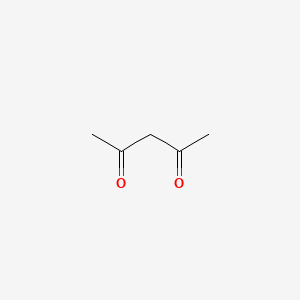| MeSH term | MeSH ID | Detail |
|---|---|---|
| Purpura, Thrombocytopenic | D011696 | 2 associated lipids |
| Eczema | D004485 | 4 associated lipids |
| Fetal Resorption | D005327 | 15 associated lipids |
| Carcinoma, Lewis Lung | D018827 | 22 associated lipids |
| Nervous System Diseases | D009422 | 37 associated lipids |
| Dermatitis, Contact | D003877 | 59 associated lipids |
| Seizures | D012640 | 87 associated lipids |
| Glioma | D005910 | 112 associated lipids |
| Edema | D004487 | 152 associated lipids |
| Adenocarcinoma | D000230 | 166 associated lipids |
2,4-pentanedione
2,4-pentanedione is a lipid of Fatty Acyls (FA) class. The related lipids are Butyrates.
Cross Reference
Introduction
To understand associated biological information of 2,4-pentanedione, we collected biological information of abnormalities, associated pathways, cellular/molecular locations, biological functions, related genes/proteins, lipids and common seen animal/experimental models with organized paragraphs from literatures.
What diseases are associated with 2,4-pentanedione?
There are no associated biomedical information in the current reference collection.
Possible diseases from mapped MeSH terms on references
We collected disease MeSH terms mapped to the references associated with 2,4-pentanedione
PubChem Associated disorders and diseases
What pathways are associated with 2,4-pentanedione
There are no associated biomedical information in the current reference collection.
PubChem Biomolecular Interactions and Pathways
Link to PubChem Biomolecular Interactions and PathwaysWhat cellular locations are associated with 2,4-pentanedione?
There are no associated biomedical information in the current reference collection.
What functions are associated with 2,4-pentanedione?
There are no associated biomedical information in the current reference collection.
What lipids are associated with 2,4-pentanedione?
Related references are published most in these journals:
| Lipid concept | Cross reference | Weighted score | Related literatures |
|---|
What genes are associated with 2,4-pentanedione?
There are no associated biomedical information in the current reference collection.
What common seen animal models are associated with 2,4-pentanedione?
There are no associated biomedical information in the current reference collection.
NCBI Entrez Crosslinks
All references with 2,4-pentanedione
Download all related citations| Authors | Title | Published | Journal | PubMed Link |
|---|---|---|---|---|
| Gerlach GF and Petzoldt K | The role of detergent in labeling of Erysipelothrix rhusiopathiae bacteria. | 1986 | Int J Nucl Med Biol | pmid:3710707 |
| Echevarria-Uraga JJ et al. | Study of the intra-arterial distribution of Fe₃O₄ nanoparticles in a model of colorectal neoplasm induced in rat liver by MRI and spectrometry. | 2012 | Int J Nanomedicine | pmid:22661893 |
| Mabkhot YN et al. | Comprehensive and facile synthesis of some functionalized bis-heterocyclic compounds containing a thieno[2,3-b]thiophene motif. | 2012 | Int J Mol Sci | pmid:22408452 |
| Qader SW et al. | Pharmacological mechanisms underlying gastroprotective activities of the fractions obtained from Polygonum minus in Sprague Dawley rats. | 2012 | Int J Mol Sci | pmid:22408403 |
| Jiang X et al. | Novel ionic liquid with both Lewis and Brønsted acid sites for Michael addition. | 2011 | Int J Mol Sci | pmid:22174608 |
| Wu TY et al. | Synthesis and characterization of organic dyes containing various donors and acceptors. | 2010 | Int J Mol Sci | pmid:20162019 |
| Spijksma GI et al. | Modification of different zirconium propoxide precursors by diethanolamine. Is there a shelf stability issue for sol-gel applications? | 2009 | Int J Mol Sci | pmid:20087472 |
| Sato H and Yamagishi A | Application of Δ- and λ-isomerism of octahedral metal complexes for inducing chiral nematic phases. | 2009 | Int J Mol Sci | pmid:20057959 |
| GarcÃa-Hernández M et al. | Eu-doped BaTiO₃powder and film from sol-gel process with polyvinylpyrrolidone additive. | 2009 | Int J Mol Sci | pmid:19865533 |
| Udayakumar R et al. | Hypoglycaemic and hypolipidaemic effects of Withania somnifera root and leaf extracts on alloxan-induced diabetic rats. | 2009 | Int J Mol Sci | pmid:19564954 |
| Kappaun S et al. | Phosphorescent organic light-emitting devices: working principle and iridium based emitter materials. | 2008 | Int J Mol Sci | pmid:19325819 |
| Clements AC et al. | Application of knowledge-driven spatial modelling approaches and uncertainty management to a study of Rift Valley fever in Africa. | 2006 | Int J Health Geogr | pmid:17156467 |
| Brooker S et al. | An updated atlas of human helminth infections: the example of East Africa. | 2009 | Int J Health Geogr | pmid:19589144 |
| Miyaki K et al. | Association between a polymorphism of aminolevulinate dehydrogenase (ALAD) gene and blood lead levels in Japanese subjects. | 2009 | Int J Environ Res Public Health | pmid:19440429 |
| Lurie DJ et al. | The dissociation of some 111In chelates in the presence of transferrin and haemoglobin studied by PAC. | 1985 | Int J Appl Radiat Isot | pmid:3918943 |
| Smith FA et al. | PAC studies of 111In binding to transferrin, tropolone and acetylacetone in aqueous solutions. | 1984 | Int J Appl Radiat Isot | pmid:6735495 |
| Pandian S et al. | Perturbed angular correlation studies of 111In-labelled platelets. | 1982 | Int J Appl Radiat Isot | pmid:6800963 |
| Sinn H | Comparison of [111In]oxine and [111In]Acetylacetone for the labeling of cells: in vivo and in vitro biological testing. | 1982 | Int J Appl Radiat Isot | pmid:6806200 |
| Abdulrahman SA and Basavaiah K | Sensitive and selective spectrophotometric determination of gabapentin in capsules using two nitrophenols as chromogenic agents. | 2011 | Int J Anal Chem | pmid:21760787 |
| Wu A et al. | Synthesis and characterization of ruthenium bis(beta-diketonato) pyridine-imidazole complexes for hydrogen atom transfer. | 2007 | Inorg Chem | pmid:18052056 |
